Being there the guys were very happy with what I was doing, they thought I was a genius because I was able to you know do generating systems and all that kind of thing, but my heart was still in rock and roll radio. I heard about this group of guys, and I think there are Army and Marines and a couple a couple zoomies (Air Force) and they were constructing a radio and television station. I understood the need for radio but a television station. Who’s going to watch tv in Vietnam. I found out they were building this or trying to build the station at the Camp Red Devil which was up over a hill behind the Seabee bases. It was probably about maybe a mile down this really sketchy road. So I went up there, got in the jeep (probably stolen from somebody) and drove up there and introduced myself to these bunch of ragtag guys.
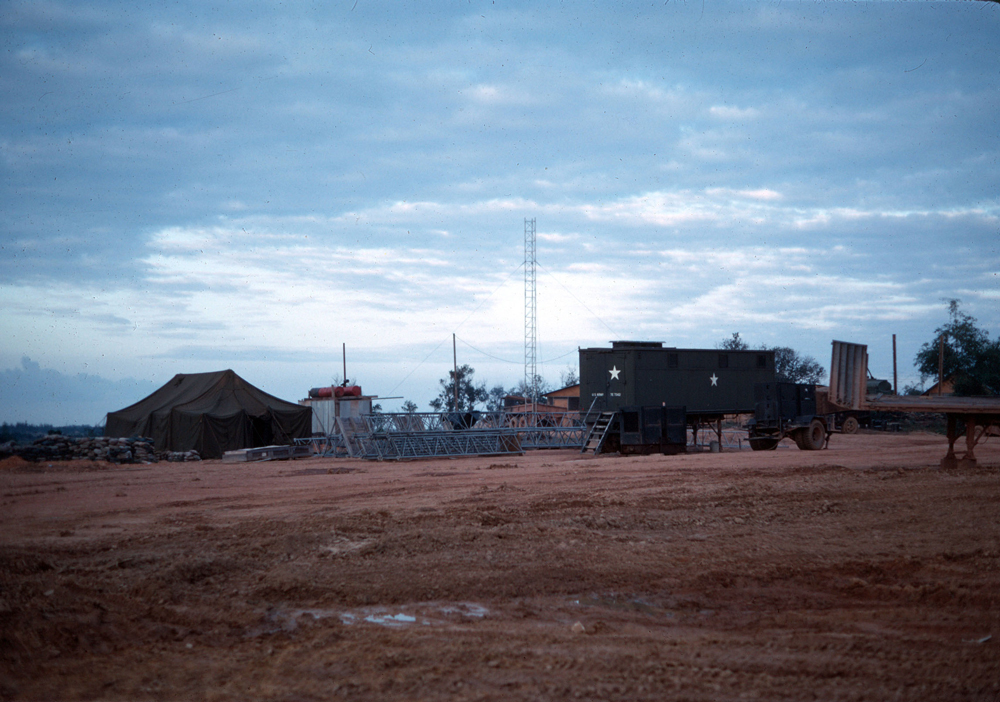
They had a tent, a trailer and a couple pieces of tower and I said, well you know I was a disc jockey back in 1964 in Erie back in civilian life. I knew how to run a radio station, I knew how to do work transmitters, knew electricity and electronics and I had a fairly good voice. I talked to these guys and they said boy, yeah we were trying to put the radio station together but we don’t have that any equipment other than this trailer that came from Hue ( a few miles south of Quang Tri) .
The reason why it came from Hue is because during the TET offensive (the new year) it was overrun, and a couple of the guys were killed and a couple of them were taken POW. I had a chance to meet with one of them at a reunion of AFVN Radio in Raleigh a couple years ago, he has since passed but he was a POW for five years in Hanoi. So here was this radio and tv station with nothing but a few pieces of equipment. I managed to get a field radio from the Air Force, this was not on the commercial frequencies, the regular am or fm band, this was military band. We started they started doing radio shows from like six to nine o’clock at night on this and anybody who had one of these walkie-talkie type radios could listen to the radio.
I managed to figure out how we could get a real am transmitter and maybe some other things so we can actually build a radio station an Armed Forces Vietnam radio station. Of course, there was the big one you know down in Saigon and there were a bunch of other what they called detachments, so we were detachment five that was our official name.

So I’m not officially part of this group yet but they really wanted me to spend some time and I said well I have a job with the Seabees and I actually have to do that. So the lieutenant, Doug Wilson, who is the commanding officer of the Armed Forces Vietnam station said to my Seabee Commanding Officer, we need this Dennis guy and we need him at the at the radio station. How can we get him transferred? Somehow, they figured out how to get me transferred from the Seabee unit to Armed Forces Vietnam radio and was the only Seabee in AFVN that I know of. Everybody else was either Air Force, Marine or Army. That would have been in July or August of 1968.
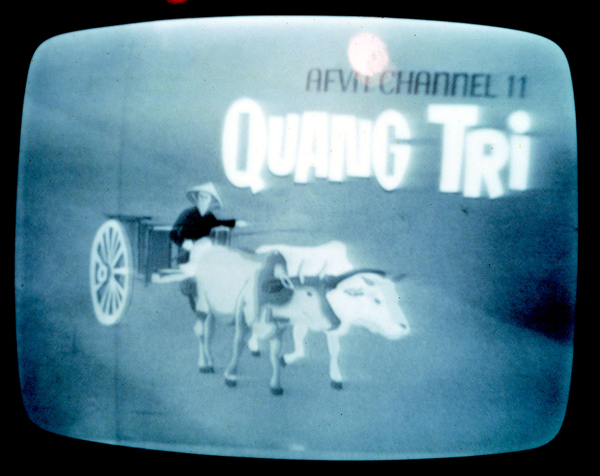
It was just an accident that I heard that that they were trying to build this radio station and I knew nothing about AFVN. I had no idea who they were and when they said tv station, I go what a tv station? What are we going to do the nightly news and who is going to watch? I was wondering, guys are going to watch television. I mean come on they’re shooting at us for God’s sakes, you know every night we’re under attack just about and we’re going to watch television? I found out that the px’s or where you could buy your military stuff on the bases in Vietnam were selling these little, tiny television sets, battery operated Sony tv sets.
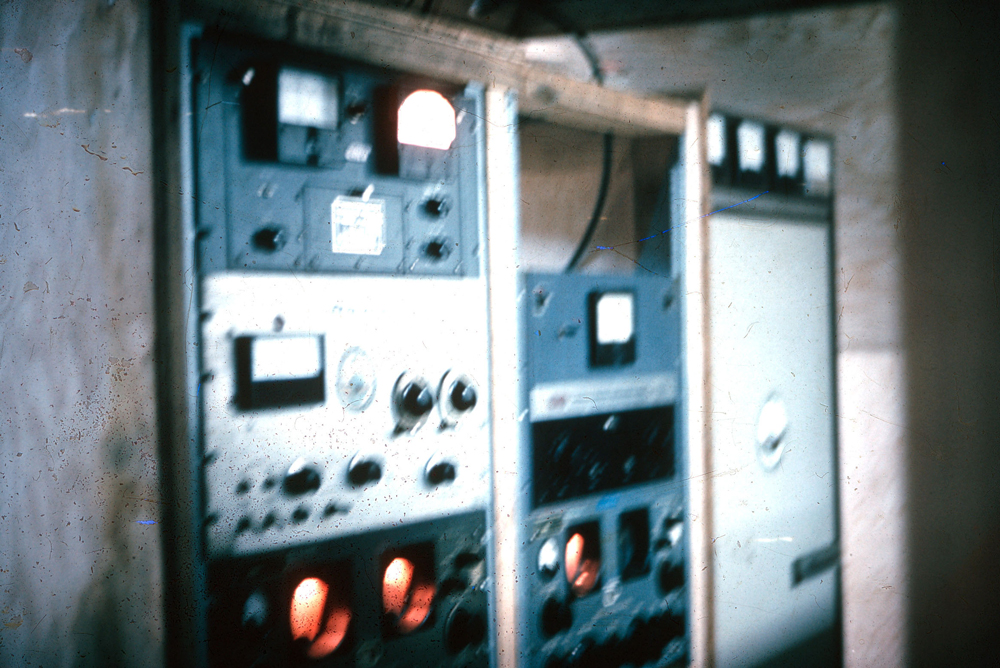
First it was important to get radio on because almost all the guys had transistor radios and they were on the commercial bands. 940 on the am dial was the transmitter that we managed to acquire. It was a Bauer 1000-watt transmitter
I remember that we had no idea how to build the tower, the people down in Saigon sent up the tower pieces but they said no engineer could come for a couple months to construct the tower. So, we go okay, how are we going to do this? Well, I had a connection with the Seabees who could supply some concrete and some small cranes. But they didn’t know how to build towers, but they knew how to lay concrete foundations and they knew how to build hooches (living quarters).
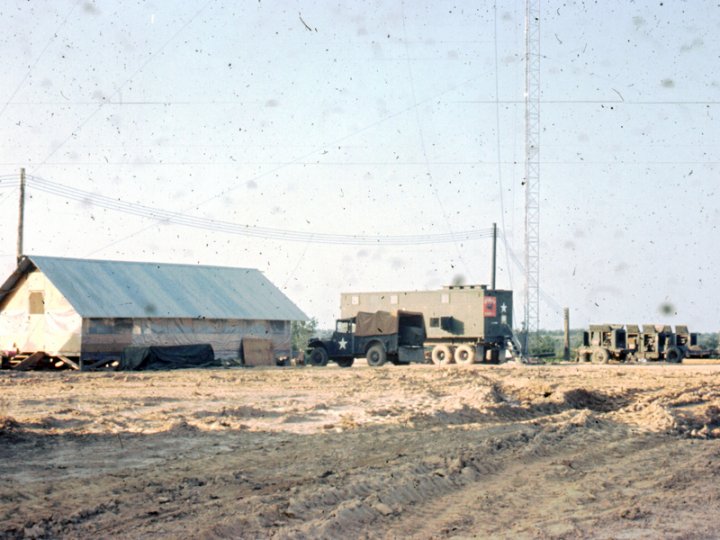
So, my Seabee buddies came up and built us four hooches, they built us what we called the office, they built a hooch for the enlisted and they built a hooch for the non-commissioned officers. They also built the radio studio and the “club”, you know a little party hooch.
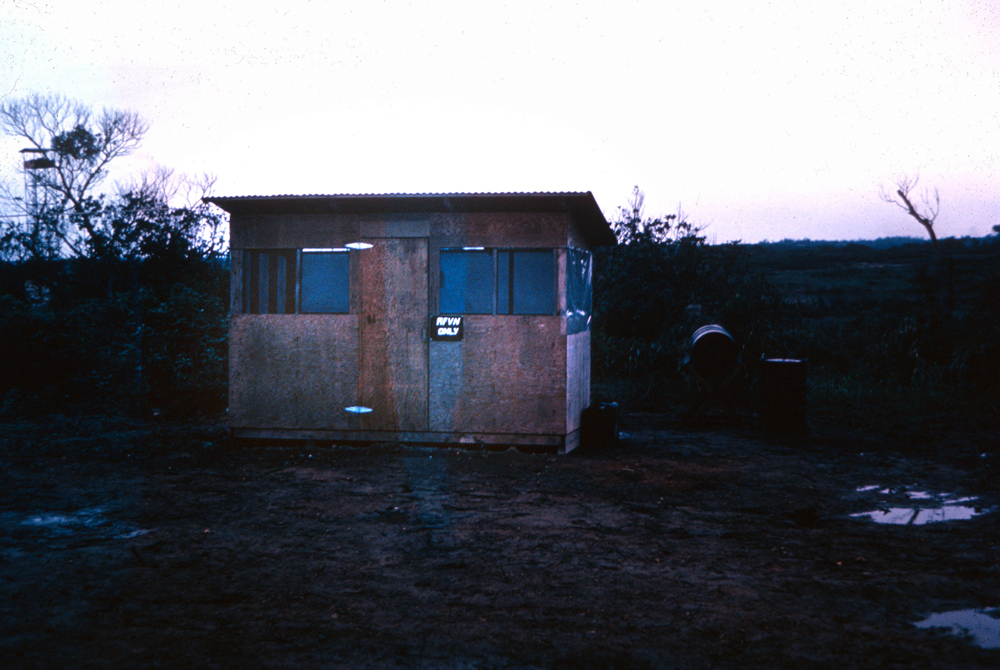
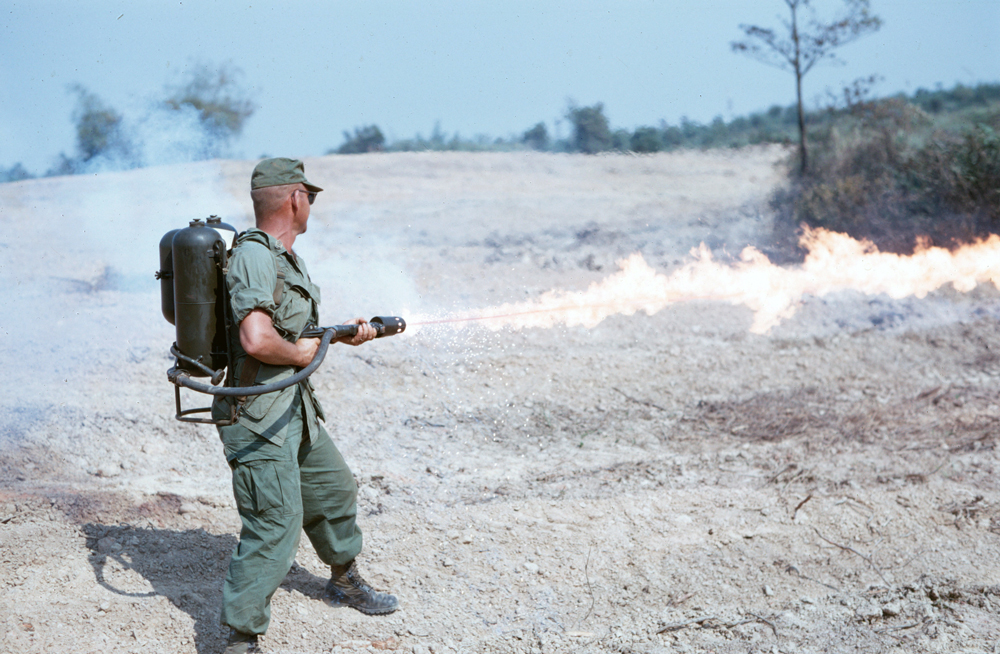
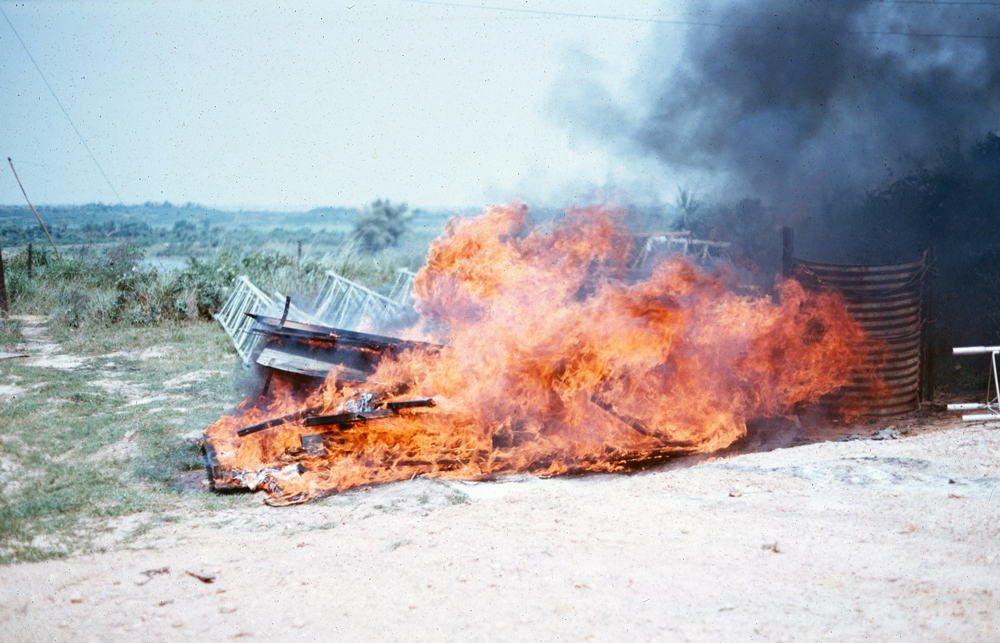
Before the hooches could be built we had to clear the land and the way we cleared the land was with this chemical that we later found out was agent orange but at the time it was it was a defoliant. We sprayed around also used a flame thrower to clear all the vegetation. Now one of use had ever used a flame thrower, but how hard could that be? We did burn down the outhouse in the process. That gel-like how flame was hard to control.
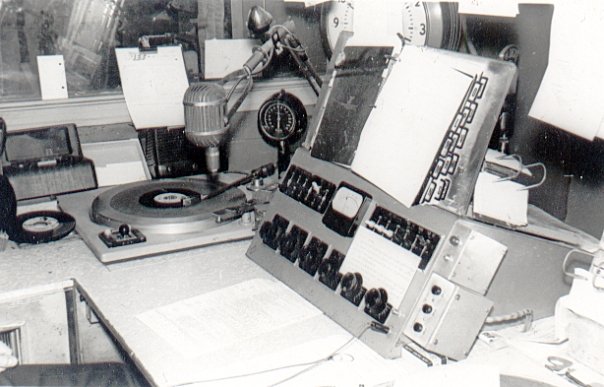
We had a little tiny generator a little that kind of worked some of the time and we had the radio studio built out of plywood and it was really pretty crude, but it you know most radio stations weren’t show places. The radio station I worked at in high school WJET in Erie was basically plywood (pictured at left). It was radio, it didn’t have to look pretty there weren’t any windows for people to see it was all what some people call the theater of the mind.
We managed to get the transmitter in we’re going how we’re going to build this tower and figured out the concepts you needed to build the tower. The principles of generating AM radio signals required laying ground radials, which is wire every degree 360. Copper wires were buried in the ground, they helped the signal get out.
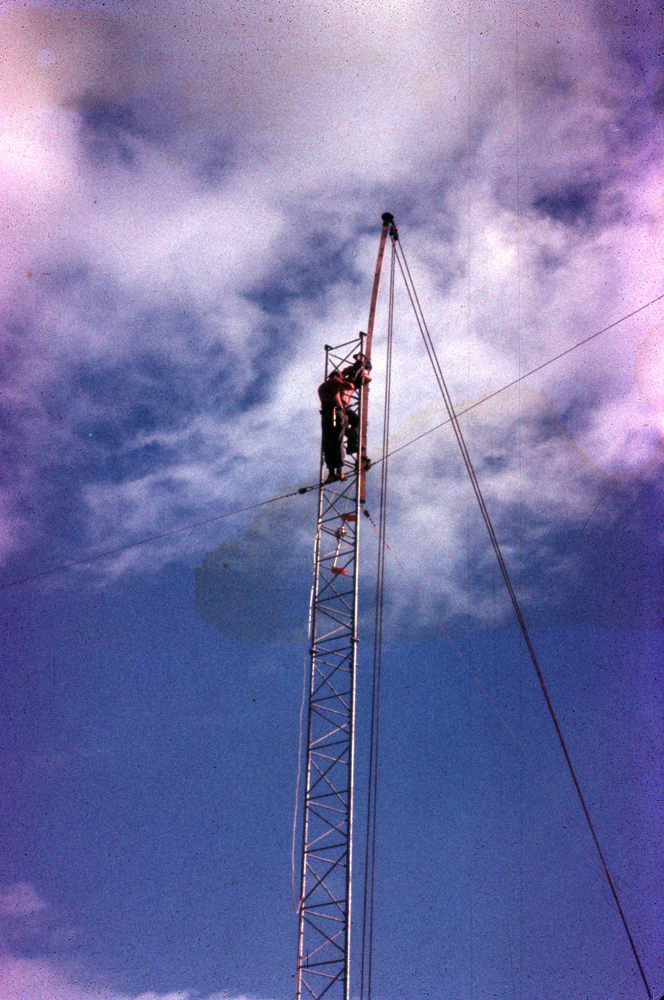
We figured if we built it in a swampy area then we would get out even further, we could even reach Jane Fonda and Hanoi Hanna up in Hanoi. We used an inflatable rubber raft and we’ve got the Seabees to build the base of the tower out of concrete. Then we started building the tower which consisted of what they call the gin pole. To build the tower, you take the first section, first section and then you attach another section to the top that would use the pole to hoist the next section up. You would just leapfrog all the way up to you got to the top. It’s a 100-foot tower we’re thinking what the hell are we doing? You know people are going to shoot at us but we built the tower and put a light on top of it too so the helicopters wouldn’t hit it.
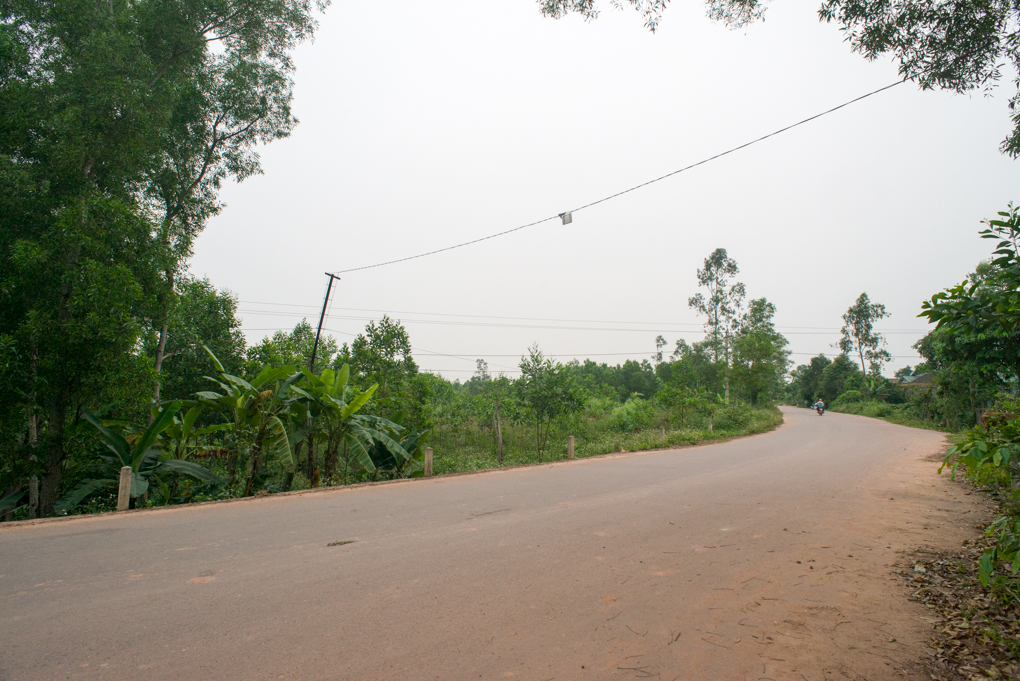
We built the built the am tower we strung the transmission line over the road, we couldn’t dig under the road so we put two poles up and then put the transmission line over the road. Back on my return to Vietnam in 2015, the poles are still there. The transmission line went into the hooch where we had the radio station, so we started broadcasting doing a regular radio show when we weren’t under fire from the Vietcong. Pictured at left from my visit in 2015 is the same road today and the poles are still there.
We were hooked up to Armed Forces Vietnam radio in Saigon by way of a long telephone line. This was a pair of wires that was connected from Saigon to us through many different other places. Every once in a while you would be listening to the network signal and you’d hear somebody speaking in Vietnamese so we wound up doing a lot of local radio ourselves.
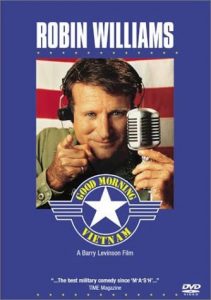
I had never been to Saigon and never heard of this Adrian Cranauer, a guy who was using the phrase “Good Morning Vietnam”. I would discover that I didn’t come up with that famous phrase until the movie came out “Good Morning Vietnam”. That was one of the things I did during my morning show from six to nine show unless we were under attack.
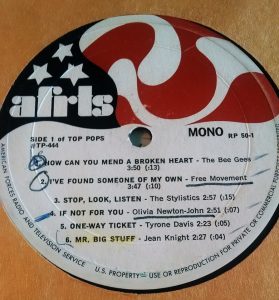
AFVN stations would be sent from AFRTS in Los Angeles where they would issue a 12-inch disc once a week. On one side would be four or five top forty songs, the other side was maybe two classical songs and maybe two country songs and maybe two middle-of-the-road songs. The music was selected not offend anyone and any drug of references to the war would not reach the stations.
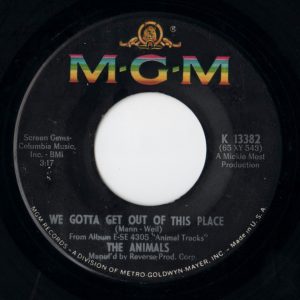
I got but luckily since I was in radio before, I had friends who would send me 45 rpm records that did not go through the government channels. Songs like “We Got To Get Out Of This Place” or “All Along The Watchtower”, all those all those songs that the government did not want us to play, we had access to.
I’m sure they could hear us in North Vietnam since we were a few miles south of the DMZ. We had a really good signal, a really good ground plane so when we would do the shows, we could annoy those in the north. After me one of the Marines, Frank Segreto, he did two hours of country I forgot the other schedules of the guys but much of the music was originated from our little radio station. We would go to the network which sounded horrible by the way, it sounded like there was very little quality to it and you could imagine what music sounded like over this long wire that went from Saigon all the way up to us near the DMZ.
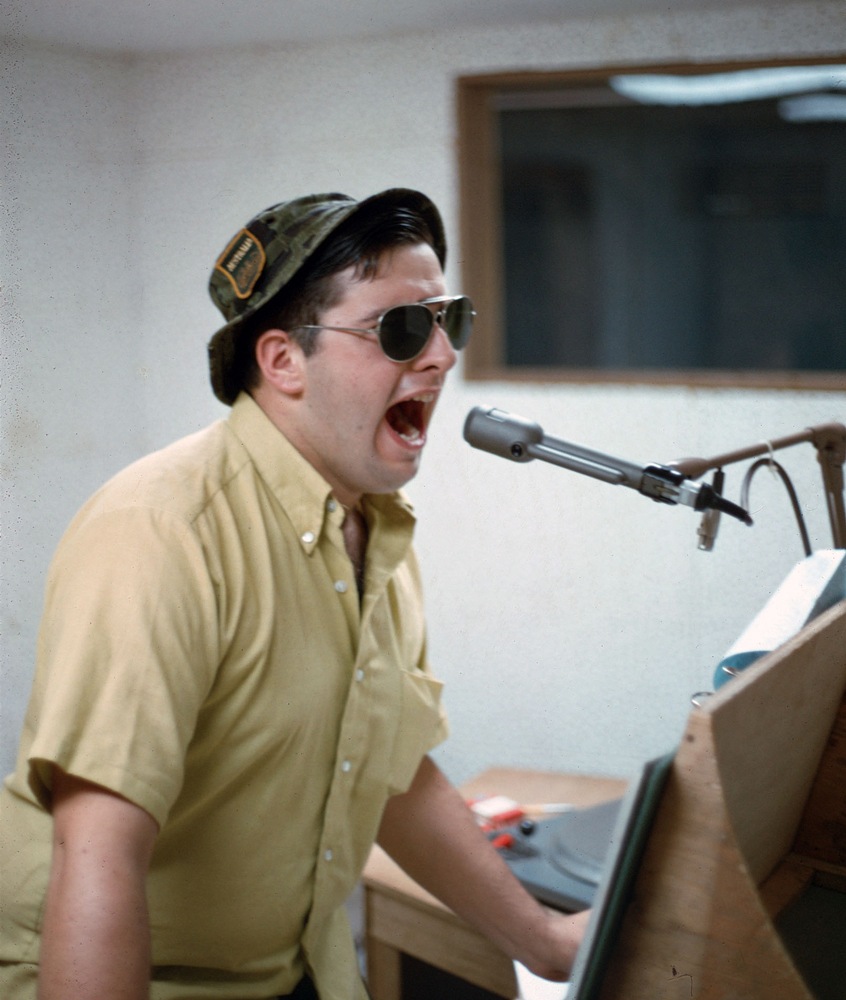
I was always a troublemaker and I decided I’m going to start my show by using something sarcastic, so I came out with “Good Morning Vietnam” that was my that was my start sign on. When the movie came out I discovered I wasn’t the guy who came up with that concept. Two years before me this this Air Force guy named Adrian Cronauer was doing that in Saigon. We never heard of him until the movie came out. A lot of years a lot of years later and that’s a whole other story.
We got the radio station going and then we managed to the TV van that came from Hue and it was shot up there were a lot of bullet holes in it and things and things needed to be repaired but we did manage to get it repaired. But we also had to build a tower and we needed a 300 foot tower, we had the parts for the tower but not the experience of how to go about erecting it.
So my Seabee buddies came to our rescue. Most of us being from areas where there was frost and needed a deep base, not realizing that in Vietnam there’s no frost we decided to build ours with support for the radio and the tv tower about 20 feet wide, 20 feet square and 20 feet deep, that’s a hell of a lot of concrete. We didn’t need that much but to this day they have never moved that piece of concrete, it’s actually the floor of someone’s kitchen right now. We had to put warning markers on the guy wires that hold the tower up because the helicopter pilots were really fond of flying close to the tower to see what we were doing so we put these markers up so hopefully they wouldn’t hit it with the helicopters.
We built the tower and we managed to get the tv van working, we had a big transmitter in there, a film chain film island to play the films sent from AFRTS. Every week we would get several cases of films. Most of them were being seen on TV in the states, but these were edited for content and removal of commercials. Programs like the Tonight Show would be about 6 months from the air date. When they would get from LA to Saigon and after Saigon showed them then they would send them to another station in Vietnam, they would go through then passed on to the next station. There were eight detachments so eventually we’d get these boxes of films. That’s how we got our film and we would schedule the broadcast day.
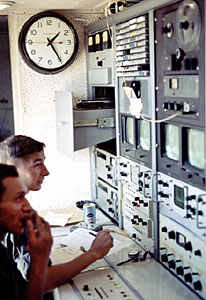
We were on from I think from three in the afternoon till maybe 10 or 11 at night. We did not do any news we just showed the films and since the films weren’t 60 minutes of 30 minutes, they would maybe be 50, 55 or some odd timing we would have film filler things, some of them were musical things, Bobby Troop produced a whole bunch of like little jazz pieces that were three four or five minutes long and we would throw those in. We would throw in announcements like your malaria pills.
We wanted to feel like our viewers and radio listeners were back home, we didn’t give military time, boy did we get in trouble for that a couple times. You have to give it 1600 hours, no! it’s four o’clock so we got some hot. We had station identification messages for the radio that we used for the station identification for the TV channel. The people in who were stationed in Saigon, which is where a lot of the air checks of armed forces Vietnam radio are from Saigon because they had all the equipment and they had the sense to record their shows, we didn’t, we were we were struggling we were trying to just keep
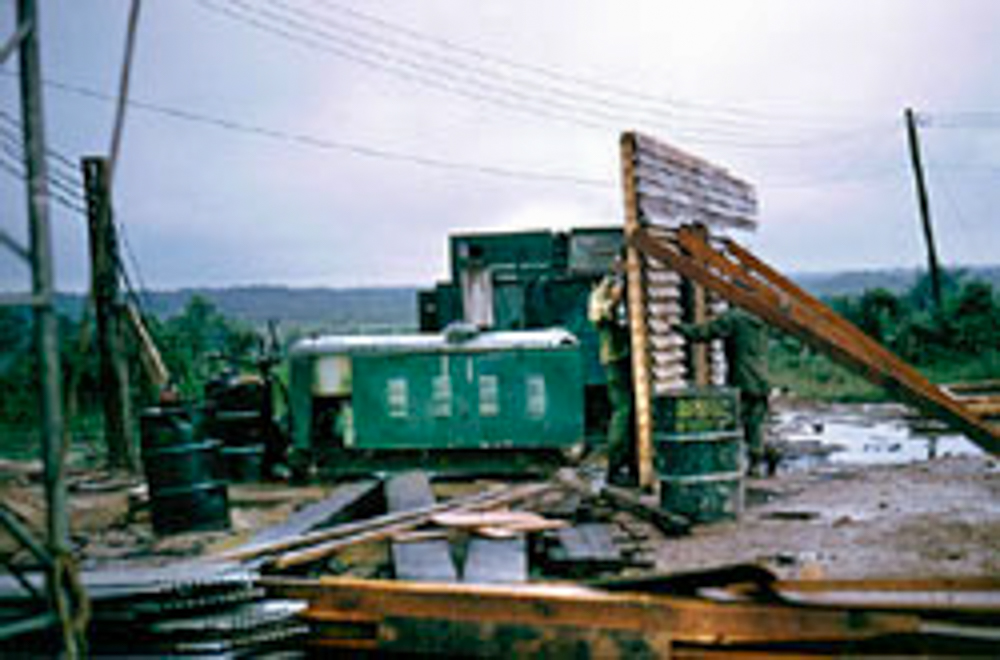
We needed a bigger a better generator, the two generators we had were so unreliable. I went on a fact-finding mission down to da Nang and you know when you send a Seabee on a mission, they will come back with surprises.
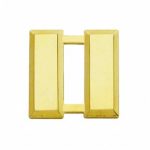
If you put some couple railroad tracks on your collar 2 bars that signified the rank of Lieutenant and you’re 18 years old, some marine will think you’re a big wig.
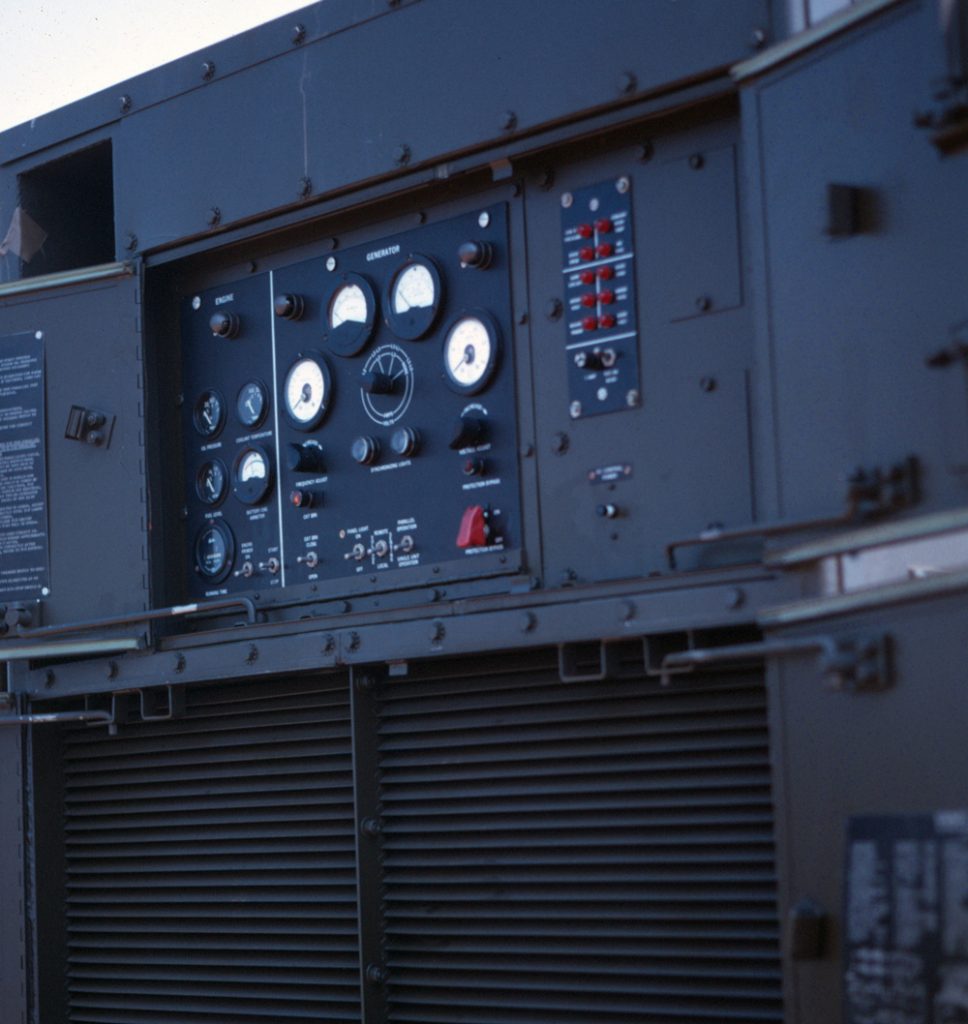
This marine at the at the depot station in Da Nang thought I was a big wig and I said Seabees are coming for that crate. In that crate was a 200-kilowatt generator. We put it on a boat, the midnight boat to DongHa. When I arrived in DongHa I had my Seabees bring a forklift and low-boy truck to take my prize to the radio station.
With a 200-kilowatt generator which meant that you must load the generator down to 80% otherwise it will run away with itself and eventually burn up. We installed this generator, and my lieutenant was happier than a clam on a Thursday afternoon, but we had a problem, we had to load down this generator and we could only provide a 20% load. On one side of us was a Army replacement depot, so replacements were coming through, they had a kitchen, they had hot food, I made a deal with them. We will provide you all the electricity if you give us one hot meal a day. My Seabees from CBMU 301 came up and installed all the wires, the poles and put the drops to wire your entire camp for constant electricity.
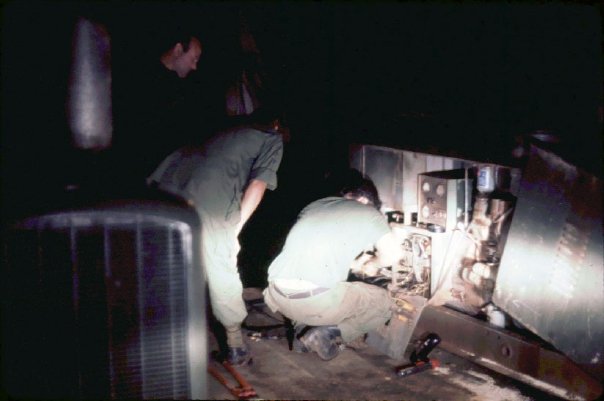
They were under the same thing we were, they had small generators, so we had a hot meal every day. On the other side of us was the Marine transportation group, well transportation group that means they had fuel, and we struck another deal. If they provide us with fuel for our generator we’ll provide constant electricity, so we formed AFVN power and light company
I would be getting up around probably around five or five thirty, we didn’t have an actual time to wake up because we were up all night depending upon you know the amount of action that was going on outside the perimeter of our camp. I would go into the radio station and fire up the transmitter. In todays world everything is on 24 hours, but there we were only on from roughly 6 a.m. until maybe 6 00 p.m. My job was to do the morning show from 6 to nine, I could do the show as long as we weren’t under attack or had to be in the bunkers so there are a couple times when I’d be middle of a record and all of a sudden you wouldn’t hear anything more other than the record ending just because we had to hit the bunkers. It was a lot safer to be in a bunker than it would be to be in the hooch.
The Vietcong weren’t targeting us necessarily to blow up the radio station because that was also a source of information, or they thought a source of accurate information. We would many times talk about things that weren’t actually happening, we loved to mess with them. If you saw the movie “Good Morning Vietnam” there was a lot of what they called censorship of the news and there was a lot of things that we just knew we didn’t want to talk about. We didn’t talk about the current people coming in or if there’s a convoy going out or we try to keep it so that we wouldn’t be the person who would be passing on the information to the enemy whether they were listening or not. We didn’t know but they probably were.
The mission of AFVN was to boost morale through radio/tv/news programming that centered around music, news and sports. I would play music; we would take requests. Now the phone was kind of like probably what they had in the United States in the early 1900s. It was a bunch of wires connected to a switchboard and somebody in there would connect you, so if you picked up the phone somewhere, of course they didn’t have pay phone, they would be like company headquarters. You pick up the phone and say “hey I want to talk to the radio station” and then they would patch through, we get some requests so we would be able to try to play.
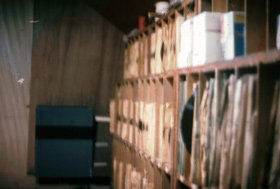
The station probably about 200 LP records, because every week they would send you from the Armed Forces Vietnam Armed Forces Radio And Television service in Los Angeles would send you a box and in that box would be one LP that contained on one side top 40 hits because the majority of the audience was at the age where top 40 rock and roll was their music, so there would be a couple maybe one or two Motown songs, then four or five rock songs. On the other side of that LP would be maybe one classical piece, maybe three country songs and maybe one or two easy listening songs. So every week we would get a new disc
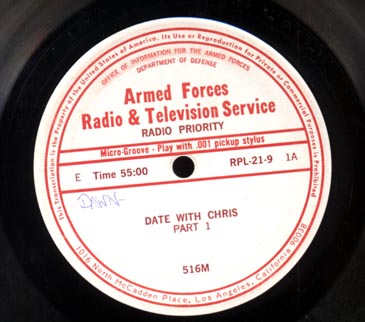
Along with the music would be several discs of full length programs recorded in LA. A favorite was “A Date With Chris”, Christ Noel, a movie actress who appeared in several films before being blackballed by the movie industry for going to entertain the troops in Vietnam.
.
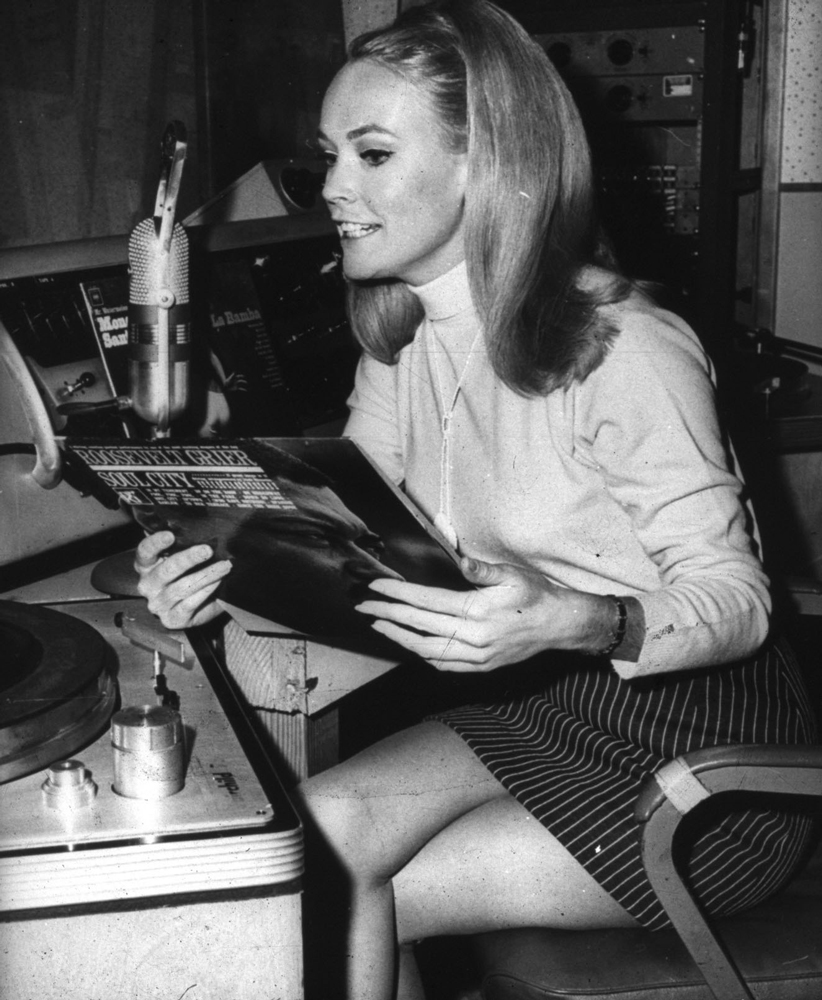
Her soft female voice was a favorite of the men in Vietnam. We would get a week’s worth of shows on 5 discs. Other “canned” programs included Wolfman Jack, Casey Kasem, Roger Carroll, Gene Weed, Tom Campbell, were among stateside radio personalities who produced programs in Los Angeles. These 55-minute programs were flown to AFVN and other American Forces stations worldwide.
Since I was a disc jockey in my civilian life, I had friends that still were in radio including Johnny Holliday, Jim Connors and Randy Michaels and they would send me records, with current music so I would get music that the Armed Forces Radio Television Service wouldn’t provide us with and some of it was maybe what they considered political, anti-war or pro-war.
There’s a picture of me where I’m playing music and you can see it’s a 45 rpm on the turntable and everybody who’s having been in armed forces radio will say, wait we never got 45 rpm records we just had the ones with the AFRTS label on it so yeah we played music that we weren’t supposed. Songs like We Got To Get Out Of This Place and “The I-Feel-Like-I’m-Fixin’-to-Die Rag,” Freda Payne’s song “Bring the Boys Home”, The Doors, “The UnknownSoldier”, and Edwin Starr, “War” along with others. We were trying to make the guys feel like they were back home, guys and the ladies too because we had lot of nurses up there.
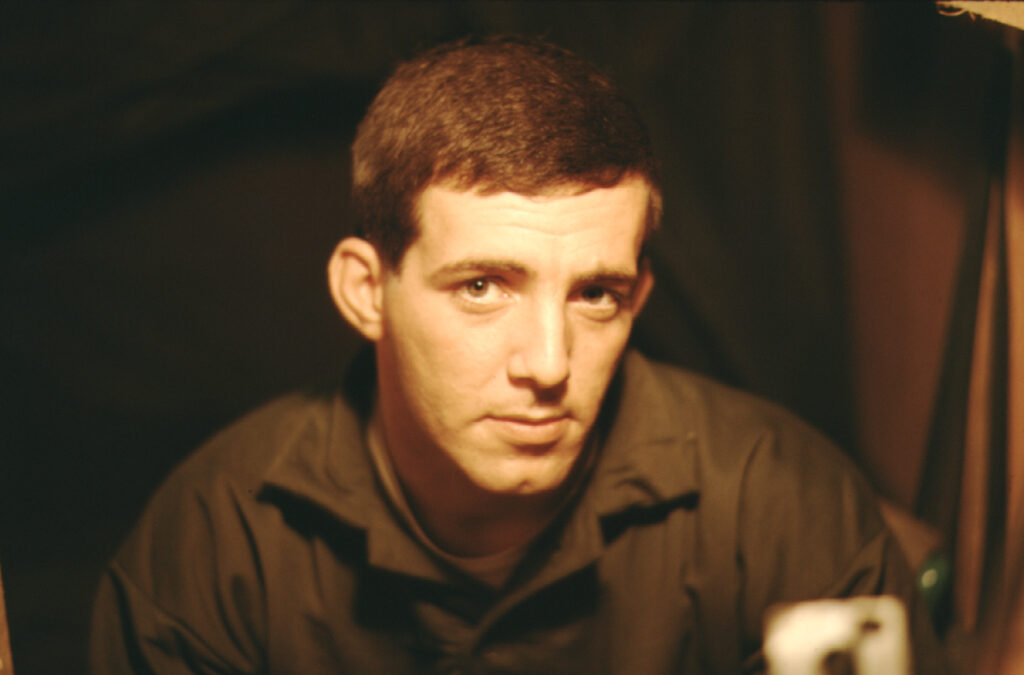
So, I would finish up around nine o’clock and then I would leave the next shift to Marine Staff Sargent Francis J. “Frank” Segreto and he did two hours of country music.
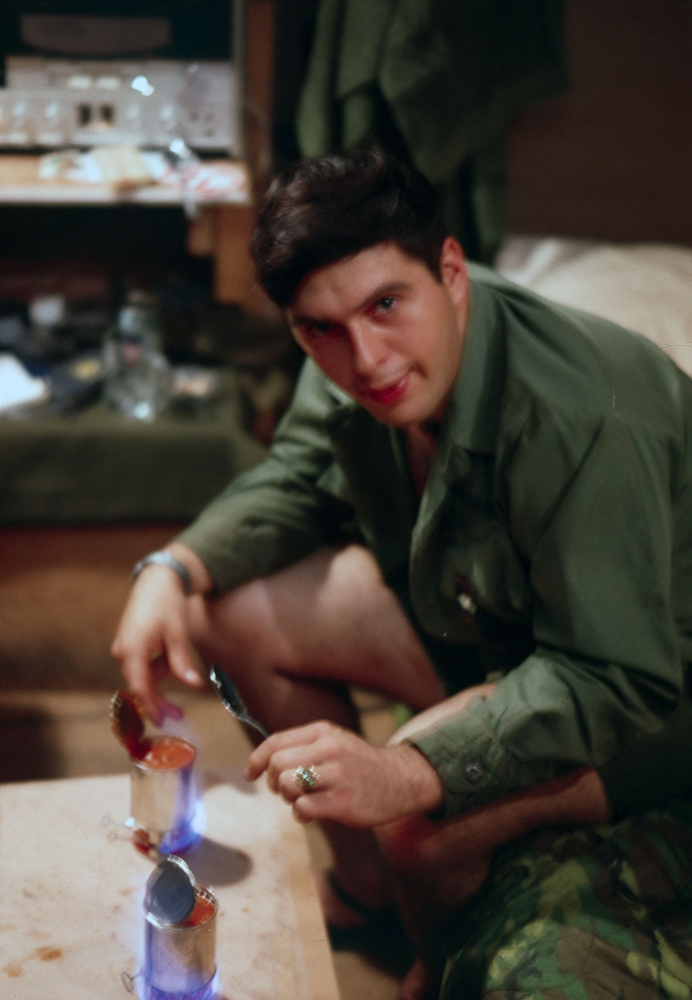
After my show, I would go and usually cook up some breakfast and that meant either a little bit of plastic explosive in a tiny that can that served as a burner because it burned really well kind of like Sterno and I would open up a can of C- rations have my breakfast.
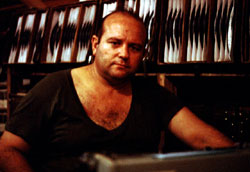
One of the many characters we had at the station was Army Staff Sargent Vic Sage, I forgot how many voices he had but he was tremendous. He was one of those guys and we would sit down and talk about all sorts of things and then he would prepare the films that we would be showing on the tv station that signed on the air I think at three in the afternoon and signed off at like nine o’clock at night. so he would be preparing the films getting them ready to carry into the van to show and also we’d be talking about what sort of promotional announcements we should be announcing like reminding guys to take the Malaria pill.
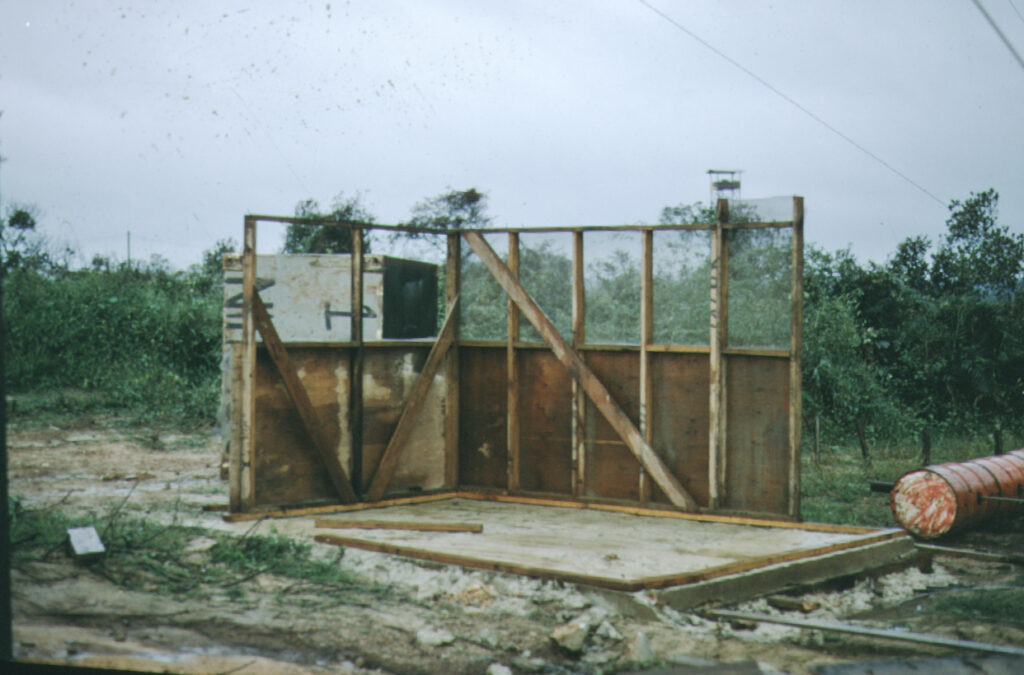
We wanted to shower because we didn’t have a shower we were just doing sponge baths but we figured out how to build a shower even though we did not know how to lay cement so you definitely had to have shoes on when you were in there the floor was a little uneven and not smooth. We used some 55-gallon drums with some submersible water heaters that were powered by I don’t know if they’re gasoline or diesel but anyhow that warmed up the water so you had at least a little bit of fairly warm water.
At lunchtime we would head over to the Army replacement company where they would have a hot lunch so we could eat it eat one hot meal. That was part of our deal we had with them we’ll provide them electricity if they provide us with one hot meal.
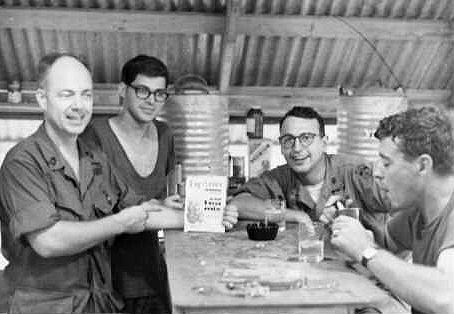
Sometimes we would go into we called “the club” it actually was just a hooch that we used that had a refrigerator and it was an area where we could gather away from you know the work area and sometimes, we show movies
We had to work that had to be done around the around the compound, rebuilding bunkers or reinforcing the bunkers of course then doing laundry because we had to do our own laundry which meant we had a couple of big silver pans and we would wash our clothes and rinse them and hang them out on the clotheslines set up. Since we were a remote station there was maintenance of the transmitter and all that other stuff so that kept us pretty busy there wasn’t a lot of down time.

Because we were in Armed Forces radio and television, we had a little a little silver badge that we were not silver but little metal pads that we would wear in our uniform. I don’t know where mine is its probably somewhere in this house. I’ve been looking for it for years , but when we had that that little badge if we wanted to fly anywhere in Vietnam all we had to do was show up at the airport and as long as there was room on a flight we could get on it we didn’t have to have orders or anything. We would sometimes fly down to Danang to see what kind of things we could acquire for our station but also go to China beach and have some cheeseburgers.
About half about halfway through your tour which would typically be one year, you could pick where to go on R&R (rest and relaxation). if you were married you would go to Hawaii. We had our choice of going to Taiwan, Hong Cong and Sydney.
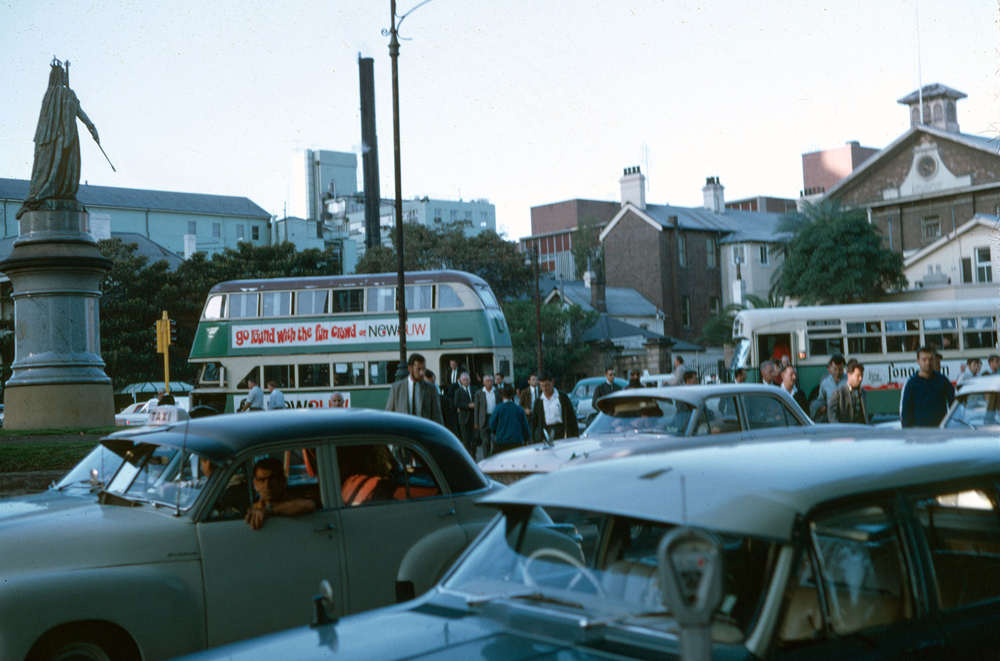
I chose Sydney Australia to go for my R&R. I just wanted to get somewhere where people spoke English, so I spent, it was always supposed to be a week a week and a couple days but it turned out to be two weeks because when I was supposed to leave I got a call saying my flight was cancelled so it would be a few more days to get back, no complaints from me. I met a Australian girl named Bernadette at the Whiskey-a-Gogo in Sydney, so she invited me out to her house. She of course had to work so I had the use of her motorcycle during the day, they drive on the left side of the road down there by the way, so I almost got myself killed a couple times.
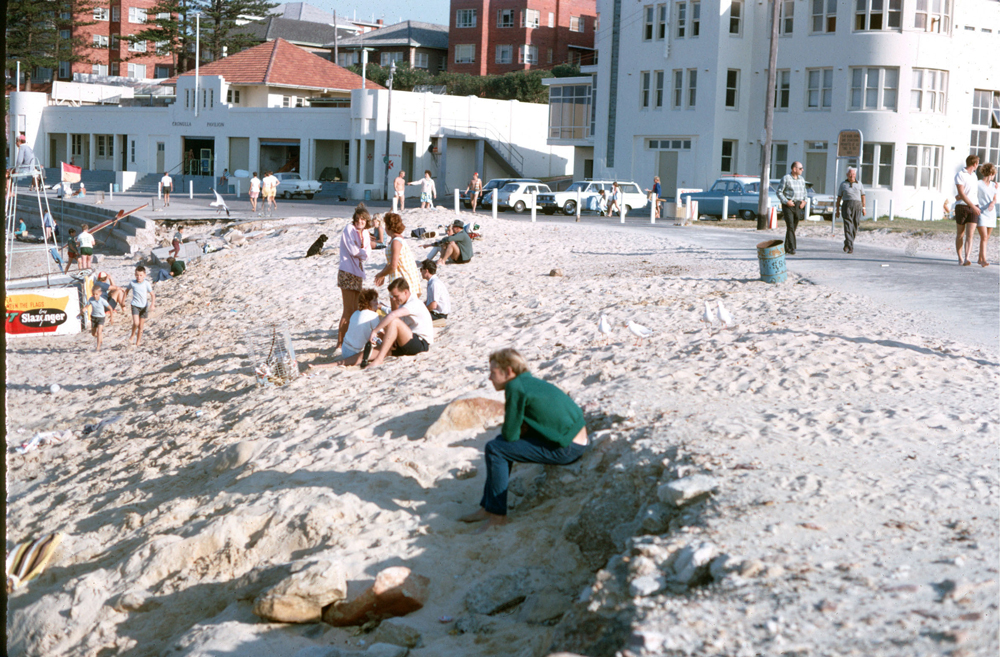
I went to Bondi beach with Bernadette and did some surfing. She lived on the beach by the great barrier reef, so every morning we’d go we’d go swimming in the morning. Only to discover now, years later there’s a lot of sharks there but at the time we never thought about it. For a while we would send tapes back and forth rather than letters, we had a little like a three-inch reel of tape I would send her talk to her about what we’re doing I’d play her some music and then she would send me back a tape and all the guys wanted to listen to it. Sadly, we lost touch over the years.
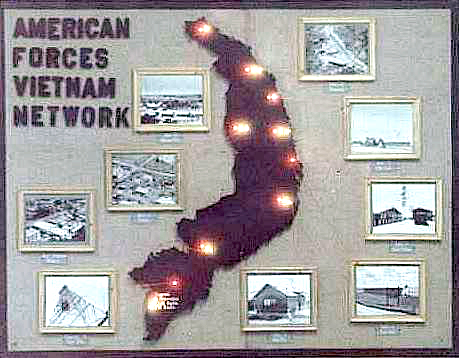
We did have a landline that connected us with Saigon but that was very unreliable, and the quality was horrible so most of the time we just did our own programming. We did our own shows and doing a show was relatively easy to do, we couldn’t run commercials we could run promotional announcements. We had we had plenty of music and we let the music speak for itself because that’s what the guys were listening wanted to hear. There were seven “up country” detachments working out of tactical production TV vans.
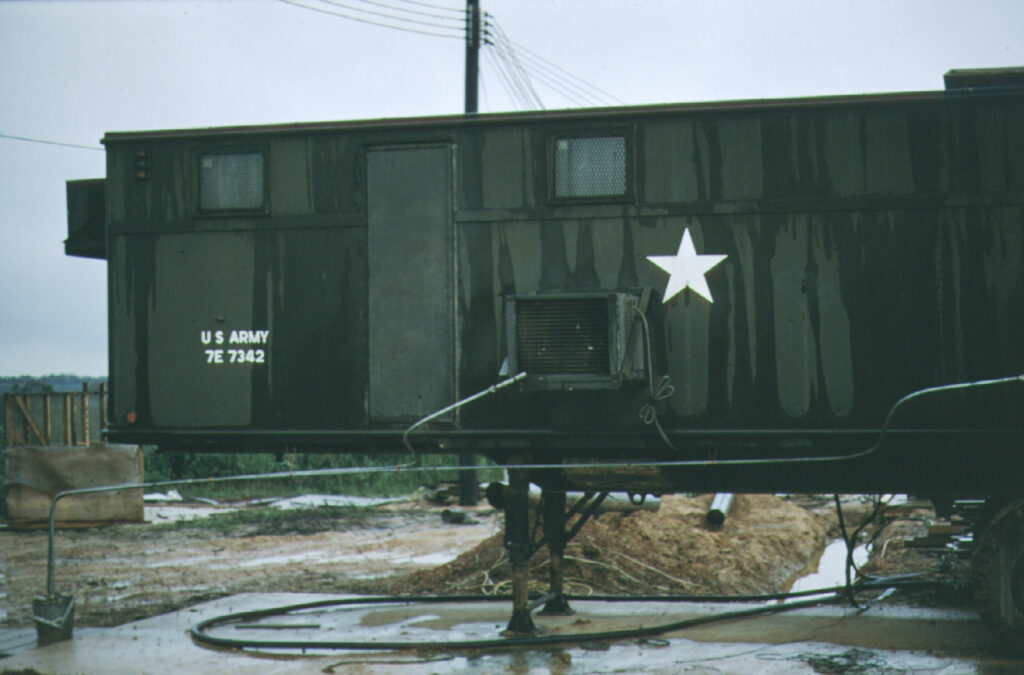
The vans were TV stations on wheels, much like a remote production truck. The units had to accommodate a working area for the staff, a studio, a transmitter and antenna. All of them also operated on Channel 11. All AFVN television outlets met U.S. broadcast specifications – 525 line, 30 frames per second, 60Hz power per an agreement with the Vietnamese government.
Because we were limited to what we got on a weekly basis, the shipment of films and they would include programs like Combat which happened to be a favorite of a lot of the guys who watched. Other shows included many of the tv shows that were seen in the states, they were stripped of political material, references to the war and commercials.
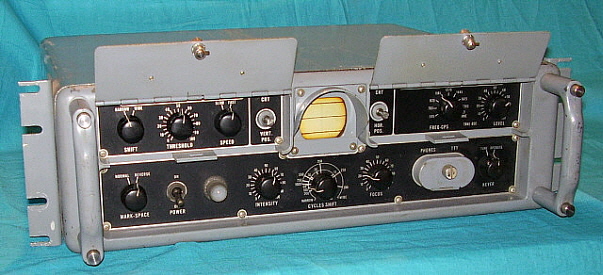
We did something that we probably weren’t supposed to be doing but we got a hold of a teletype receiver, this is a receiver that would receive teletype signals probably received everything else too but we hooked this receiver up to our teletype machine that would normally come from Saigon. (Picture is a receiver that was similar to what we used)
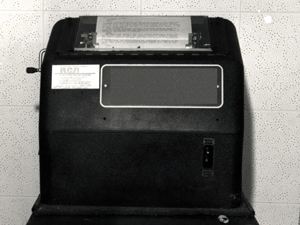
We hooked up this receiver to the teletype machine, so we got a hold of UPI (United Press International) or AP (Associated Press) from Tokyo. We were receiving uncensored news which was something not permitted so we had to be careful about we used on air when we did our newscast. Though we were really pretty responsible bunch of wild guys we did have some responsibility what we say on the air.
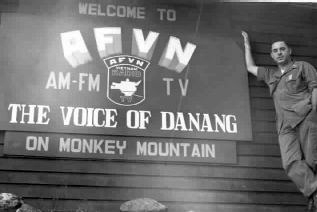
We didn’t necessarily wear uniforms a lot of times we were just in our shorts and combat boots and socks and probably not a not a shirt though if we were going somewhere in the jeep and being on the roads, we would normally put a shirt on and a flak jacket sometimes and carry our m16 just in case. I feel sorry for that when I go down to Danang, I go up on monkey mountain and go visit the guys at the radio station there, of course they had to wear their uniforms and their polished boots and all this other stuff.
When the movie “Good Morning Vietnam” came out, that’s when I discovered I didn’t invent the Goooooooooood Morning Vietnam saying. It was created in 1965 by Adrian Cranauer. I spoke with Adrian a couple of years ago before he passed, we had dinner in Washington DC. He invited me down to have dinner with him and I went down thinking okay we’re going to some fancy restaurant in DC.
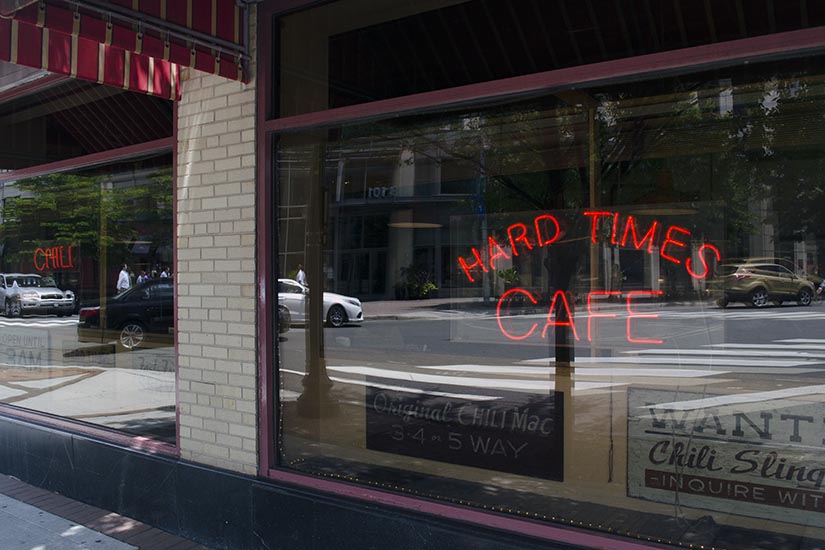
He took me to a pool hall into a beer joint called the hard times chili café in clarendon, right outside of Washington. We spent four hours or maybe longer until the ownership finally said ‘can you guys go home we want to close up’ We told stories his life and my life and what the movie kind of portrayed, though it took liberties with some of the some of the events just for film. In Saigon he had hotel room, maid service, hot meals and of course had to deal with the brass who were everywhere.
In Quang Tri, we were right close to the perimeter of the base so you know we got we got rocketed and would hear bullets whizzing through the air that’s where we’re walking them you know around the compound and stuff, so we had that threat daily. Granted in Saigon they did have they did have some concern and some attacks but not like daily for us, it was like are we going to survive are we going to live to play the more hits tomorrow
We didn’t have a format that says you have to play up tempo-up tempo soft-up tempo medium-up tempo, we just whatever we felt was going to sound good for the show. Now in Saigon they had a different story they had a they had a music clock and they had to follow that clock and they had to play the music supplied by AFRTS in LA, unless, like Adrian, sometimes would kind of play records not supplied by AFRTS.
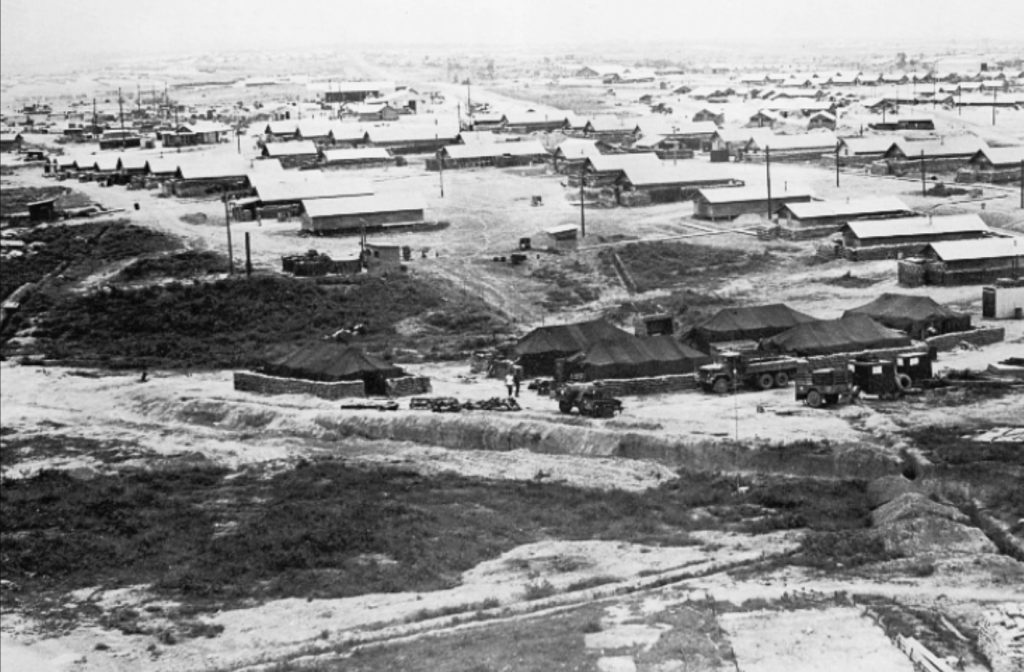
When I first arrived to my duty station with the Seabees in was near the DMZ. The Seabees first built their camp in DongHa which was fairly close to the DMZ only to discover that, oh yeah the rockets can hit here so after the rockets blew up the ammunition depot and a couple other things they decided, ah let’s kind of abandon the DongHa area but they needed DongHa because that was the access to the Cuaviet river which would be the access to the south China sea so they still needed that ramp to be able to bring supplies in but a lot of the combat troops moved south to Quang Tri.
Quang Tri had a had a massive airport a really large airport and both that housed helicopters and also could land the big planes and then the c-130s and was not reachable by rockets.
There are there are parts of my military career especially in Vietnam that I don’t remember whether I blocked them out or I probably just blocked them out subconsciously, but I was told by one of the guys that we had a reunion down and, I forget where but Tom Deener, who was one of the guys with us he told me this story. We were under ground attack during one day and there was a little kind of a like a depression that led to where the perimeter of the base was and we were under attack and he told me the story about how I decided that it would be really cool if I put two bands of ammo across my chest and picked up an M-60 machine gun and started walking down that path and blowing away anything that was coming up the path.
To get supplies we would sometimes have to go to DongHa, Danang was a plane ride, DongHa was a jeep adventure. The road we would take was called highway one, it was a dirt road, but the Seabees eventually paved over with asphalt, which is now by the way, a four-lane highway with a boulevard and the bend is still there. When I went back in 2015, we drove from Quang Tri to DongHa, the bend is still in the road.
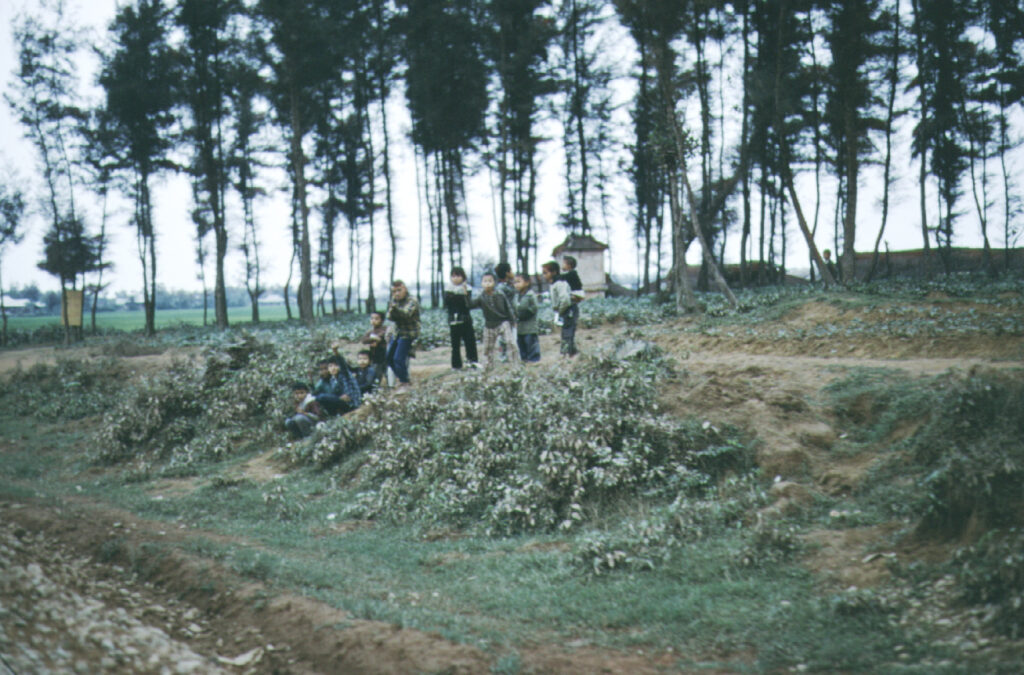
In the 60s, the kids would want us to throw candy, we would throw candy to the to these little kids and in turn they threw a grenade at us. which was not really very appreciative of us. Most times we managed to get the grenade out of the jeep before it exploded but it was like come on kids.
As Americans we know they’re children they’re little children but they’re throwing grenades at us, yeah and if we’re walking in the streets you had to be careful because they would take a razor blade and they would slice your back pocket to get your wallet or whatever but you know they wouldn’t be careful and sometimes they’d slice too far into your flesh and you’d wind up with a very large wound. But we trusted kids we trusted children but we learned very quickly that you can’t trust everyone
